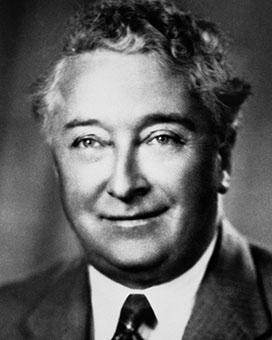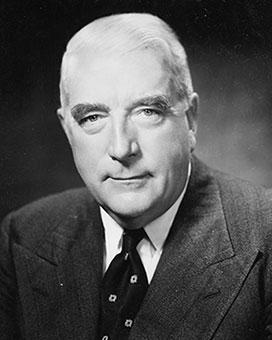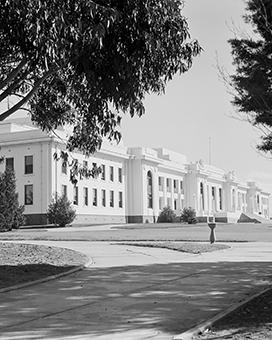Earle Christmas Grafton Page qualified surgeon and set up a hospital in his home town of Grafton, New South Wales. From 1913 to 1919, he was involved in local government politics, and served for 12 months in Army hospitals overseas in 1916. Page entered Federal Parliament in 1919 and helped form the Country Party. In 1923, he became Deputy Prime Minister in a coalition government with Stanley Bruce. He was a strong force in policy-making for rural interests until the government fell in 1929.
The Country Party sat on the parliamentary cross benches until 1934 when Prime Minister Joseph Lyons formed a coalition government and Page again became deputy Prime Minister. When Lyons died in 1939, Page became 'caretaker' Prime Minister.

Dr Earle Page, deputy Prime Minister and Treasurer, in 1928. NAA: A3560, 4622
Early years
Page was born on 8 August 1880 in Grafton, on the Clarence River in northern New South Wales. He was the5th of the 11 children of blacksmith Charles Page and Annie (Cox) Page.
Page went to school in Grafton and won a scholarship to undertake his final year at Sydney High School in 1894. He was only 14 when he enrolled in an Arts degree at the University of Sydney. He won a prestigious scholarship at the end of the year that enabled him to transfer to medicine in 1896. He topped his final year in 1900, and spent 2 years working first as a house surgeon and then as a pathologist at Sydney’s Royal Prince Alfred Hospital.
In 1903, Page returned to Grafton to set up in general practice. He raised the funds to open a 13-bed private hospital in Grafton, and appointed Ethel Blunt, whom he had met as a theatre sister at Prince Alfred Hospital, as matron. She had not only topped her year as a nursing graduate, but had experience running a hospital at Manly in Sydney.
Fascinated by technology, and with an extensive region to cover in his medical practice, Page bought a car in 1904. It was the first in the district and among the first in Australia. He also installed the first X-ray machine in New South Wales at his hospital – the first demonstration of X-ray properties had only been 7 years earlier in 1897, when Page was still at university. Page also developed other business interests, buying a Queensland sawmill and land for dairy farms. In 1906, he and Ethel Blunt married.
South Grafton Council 1913–19
In 1910, the Pages travelled to New Zealand for a medical conference and also toured hydro-electricity projects there. In 1913, Page was elected to the South Grafton Council, enabling him to pursue his goal to develop a hydro-electric scheme for the Clarence River. The New South Wales Public Works Department commissioned a report on the proposal, but when no action was taken, Page increased his political activities to get the state to act.
By the time the First World War began in 1914, Page had become an influential local figure. He was prominent in the Farmers and Settlers Association, and in July 1915, founded the Northern New South Wales Separation League. The ‘new state movement’ aimed to establish a 7th state in north-eastern New South Wales. In December that year, Page bought an interest in Grafton’s Daily Examiner.
In January 1916, Page enlisted in the 1st Australian Imperial Force (AIF) Army Medical Corps. For 12 months, he served in military hospitals in Egypt, then in England and France. He returned to Australia in March 1917 and received his discharge in July. Within 1 month, he resumed his political activities, arguing for a new state, and also for wider Commonwealth control of national development.
On his way back to Australia in 1917, Page had inspected hydro-electric projects in Canada and the United States. He was elected mayor of South Grafton in 1918 and began to lay the groundwork that, 6 years later, established the Nymboida hydro-electric scheme.
State and national farmers’ political organisations had lobbied William Hughes’ Nationalist government to introduce a law changing the method of counting votes in House of Representatives elections to a preferential system. In 1918, the Victorian farmers’ organisation fielded a candidate in the by-election for the seat of Flinders, covering semi-rural and bayside areas south-east of Melbourne. Stanley Bruce was the Nationalist candidate, and to improve the chances of his election, the farmers’ group agreed to direct supporters’ votes from their own candidate to Bruce. In return, they wanted the preferential system introduced. Bruce won the seat, and on 21 November 1918, the new law was enacted.
Member for Cowper 1919
In the 1919 federal election, Page won the seat of Cowper, one of the 11 seats won by members of farmers’ groups. Page and 6 of these members formed a federal Country Party on 24 February 1920, 2 days before the opening of Federal Parliament. The new party was initially led by WJ (William James) McWilliams. Members sat on the cross benches, generally supporting William Hughes’ Nationalist government. That year, the Pages, now with 5 children, moved to the Sydney suburb of Strathfield. Sydney was a midpoint for train travel between Parliament in Melbourne and Page’s electorate on the north coast of New South Wales. In 1922, the family bought 'Boolneringbar', a large pastoral property on the upper Clarence River, and a second house in Strathfield.
On 5 April 1921, Page was elected leader of the parliamentary Country Party. The party was unaligned and held the balance of power in the House of Representatives. In the long parliamentary recess between December 1921 and June 1922, Page visited Java, Singapore and Malaya with businessman Herbert Edward Pratten, looking at Australia’s trade opportunities there.
At the House of Representatives election in December 1922, 14 Country Party members were returned, while the Nationalists won only 26 seats. Prime Minister Hughes was forced to seek an alliance, but the Country Party members refused to work with a government that included him. Hughes resigned as prime minister and leader of the Nationalist Party in favour of Stanley Bruce.
Page formed a coalition government with Bruce, negotiating a generous deal for the new party: the deputy prime ministership, 5 Cabinet positions, and a joint ticket in campaigning for Senate elections. Page’s strategy had transformed the new party – it no longer sought concessions from government, but shared the reins of government.
Deputy Prime Minister 1923–29
On 9 February 1923, Page was sworn in as Treasurer in the new coalition government. The Bruce–Page coalition adopted a 'Men, Money, Markets' policy for economic development through British immigration and investment, Empire trade preferences, and legislation to subsidise production and export of agricultural produce. The focus on 'Empire agriculture' meant securing British markets for Australian produce, and reflected the significance of the coalition partnership for the new Country Party.
In June 1923, the government held a special conference of state premiers to review Commonwealth–State financial relations and other federal arrangements. Among the outcomes was the voluntary Loan Council set up in 1924, and the successful referendum in 1928, which made this a statutory body. As Treasurer, Page chaired the Council from its early days in 1924. Page was also twice acting Prime Minister for extended periods while Bruce attended the 1923 and 1926 Imperial Conferences. During the first 4-month term, he made history when, in Bruce’s stead, he chaired the first Cabinet meeting held in Canberra, on 30 January 1924.
In March 1925, Page went to London for discussions on the gold standard, and to the United States to promote the rural credit scheme he devised. In November, the coalition government was comfortably returned at the federal election.
The Bruce–Page government passed legislation to separate the trading and central bank functions of the Commonwealth Bank, and also established a ‘tied grants’ scheme to assist the states in building roads. As well as the rural credit scheme, Page devised an investment fund to finance the Council for Scientific and Industrial Research, later the CSIRO.
After the formal opening of the new Parliament House in Canberra on 9 May 1927, the transfer of federal government departments to the new national capital began, including Page’s Department of Treasury. That year, Page joined Sydney’s exclusive Australia Club, and the following year the Pages built a new house in Wollstonecraft on Sydney’s north shore – it was soon to be linked to the city by the Sydney Harbour Bridge.

Deputy Prime Minister Dr Earle Page on the steps of the new Parliament House in Canberra in 1927. NAA: A3560, 3581
The Bruce–Page government met a serious obstacle when its National Insurance Bill did not proceed past its second reading in Parliament. Then, at the federal election in November 1928 the coalition’s majority was reduced. In 1919, unrest, prompted by the government’s industrial relations policies, heightened with the introduction of the Maritime Industries Bill, designed to dismantle the Conciliation and Arbitration Court. William Hughes took the opportunity to gather the numbers to help the Labor Opposition defeat the government, on the Bill, and precipitated an election.
At the election on 10 October 1929, Page was unopposed in his electorate, but Prime Minister Stanley Bruce lost his own seat. Both the Country Party and the Nationalist Party lost support, and a Labor government was elected.
Out of office 1929–34
The Labor government of James Scullin was sworn in on 22 October 1929, with economic depression imminent. The Nationalist Party expelled those who had brought down the Bruce–Page government, including William Hughes. John Latham replaced Bruce as party leader. Latham was Leader of the Opposition, but Page as Country Party leader was an equally strong opponent of the ‘socialist’ federal and state governments.
Page was a major critic in February 1931, when New South Wales Premier Jack Lang threatened to repudiate loan payments to British bondholders. He revived the 'new state' proposal for northern New South Wales, and supported similar movements in the Riverina and mid-western New South Wales.
In May 1931, federal Labor minister Joseph Lyons formed a breakaway group and contested the December election as the United Australia Party. The Country Party decided to remain separate, but before the election Page negotiated a coalition plan with Lyons. When the United Australia Party was returned with enough seats to govern, Lyons formed a Cabinet without the Country Party. One sticking point with manufacturing supporters of the new party was Page’s insistence that the Country Party should hold the Trade and Customs portfolio if it joined a coalition government. In March 1932, Lyons offered three Cabinet vacancies to the Country party as long as Lyons could choose his ministers, but Page rejected this condition. The Country Party thus remained on the cross benches for the first 2 years of the Lyons government.
In January 1933, the Pages’ eldest son Earle was killed by lightning while working on their Clarence River property. The couple spent most of the year there after the tragedy. Page had initially decided to resign the party leadership, but instead took 9 months leave of absence.
Deputy Prime Minister 1934–39
With United Australia Party members reduced at the federal election in September 1934, Prime Minister Joseph Lyons formed a coalition government with the Country Party, and Page was once more deputy Prime Minister.
In the new Cabinet, the Country Party held 4 of the 14 portfolios. As Minister for Commerce from 1934 to 1939, Page won the inclusion of some agricultural machinery on the tariff-free list. In May 1935, Page founded a voluntary Australian Agricultural Council to coordinate marketing. In May 1936, Page led a trade mission to London, gaining some increases in sugar and beef export quotas. Page had been a vocal critic of Lyons ‘barren results’ in negotiating the Ottawa Treaty, and enjoyed his own reputation as a champion of imperial preference. Lyons’ standing as Prime Minister was under threat on this issue. In 1934 Page attempted to persuade Stanley Bruce to return to Australia to take over leadership of the United Australia Party.
A United Australia Party–Country Party coalition had governed in New South Wales since the dismissal of the Lang government. In April 1936, the state government appointed Page chairman of a New England University College Council. The college was officially opened 2 years later, and Page held this post for almost 20 years. When the University of New England was established in 1955, he became the university’s first chancellor.
The Pages went overseas again from April to July 1938, when Page headed the trade mission to London for the revision of the 1932 Ottawa Treaty. On 22 July 1938 they attended the dedication by King George VI and Queen Elizabeth of a memorial to Australian troops at Villiers-Bretonneux. Page was awarded the KCMG on this visit.
After the coalition was returned at the 1937 election, Page also became Minister for Health, a portfolio he held from 1937 to 1939. From October 1938, Page was acting Prime Minister during the illness of Joseph Lyons, and chaired a conference of state premiers on national security and planning. In November 1938, the Parliament passed the Wheat Industry Assistance Bill guaranteeing growers a profit margin by taxing flour when the domestic price fell.
On 20 February 1939 in a speech at Kempsey, in his electorate, Page indicated that Cabinet might defer introduction of a proposed national insurance program. Parliament had finally passed the necessary legislation, and the proposal was one Robert Menzies had pushed. Relations between the 2 men were hostile at best. Then on 1 March 1939, Prime Minister Joseph Lyons announced Cabinet’s postponement of national insurance to a meeting of his United Australia Party. 2 weeks later, Menzies resigned as deputy leader of the party in protest. Then, in the first week of April 1939, Prime Minister Joseph Lyons suffered a series of heart attacks. On Friday 7 April, Lyons died in hospital in Sydney and Earle Page became Prime Minister.
Sources
- Bridge, Carl, 'Earle Christmas Grafton Page', Australian Dictionary of Biography, Vol. 11, Melbourne University Press, Melbourne
- Ellis, Ulrich R, A History of the Australian Country Party, Melbourne University Press, Melbourne, 1963.
- Page, ECG, Truant Surgeon: The Inside Story of Forty Years of Australian Political Life, Angus and Robertson, Sydney, 1963.
From the National Archives of Australia collection
- Page, Earle Christmas Grafton 1914–18 (WW I Personnel file), NAA: B2455, Page E C G
- Dr Earle Page’s criticisms of repatriation expenditure, 1921, NAA: A2487, 1921/7907
- Programme of Road Construction in the Different States in conjunction with relevant Commonwealth Legislation, 1927, NAA: A106, G1927/692
- Dr Earle Page – attendance at International Sugar Conference – 1935, 1936–38, NAA: A461, 748/1/397 Part A





